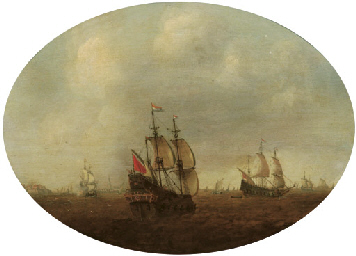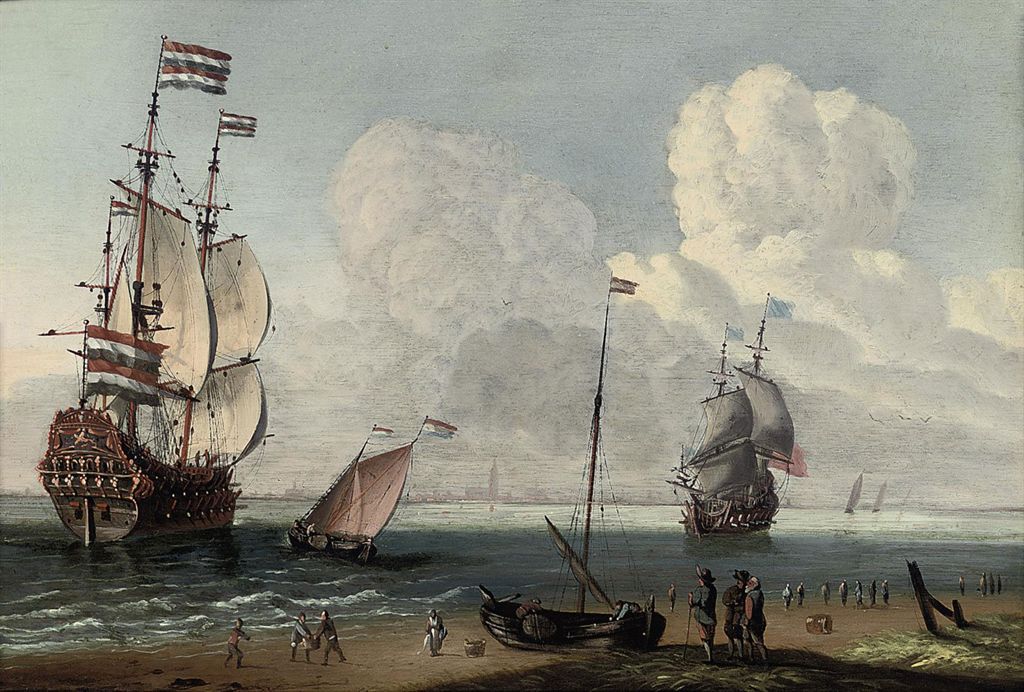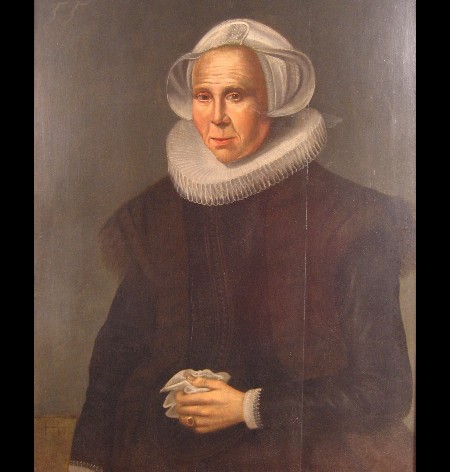DUTCH SCHOOL, 17th century FLORILEGIUM -- Manuscript Flower Book, containing 198 original drawings of tulips and other plants. [Low Countries: first quarter of the 17th century]. 2 (royal folio, paper various sizes from 465 x 290mm. to 380 x 245mm.), 198 ORIGINAL BLACK CHALK, BODYCOLOUR AND WATERCOLOUR DRAWINGS OF FLOWERS ON PAPER, on 198 leaves foliated 1-67, [67A], 68-193, [194-197] in a 17th-century hand, including 4 later drawings (three mounted) bound in at the end, of the rest 73 leaves captioned in ink in three different hands, 37 with captions pasted-on, manuscript references to Dalchamp's Historiae generalis plantarum (1586-87) on 11 drawings. (One drawing rubbed, some marginal light staining.) Late 17th century Dutch sprinkled calf, spine gilt, uncut (rebacked neatly preserving original spine, corners neatly repaired). A RARE EARLY MANUSCRIPT FLORILEGIUM, PROBABLY THE CATALOGUE OF A FLOWER DEALER, DEPICTING NEW AND EXOTIC FLOWERS, INCLUDING 76 VARIETIES OF TULIPS. The album is made up of 173 drawings of specimens grown from bulbs or corms, and the remainder flowering plants. The drawings are grouped by family: Narcissi and Daffodils (6); Snowdrops (2); Crocuses (13); Fritillaries (2); Irises (4); Hyacinths and Grape Hyacinths (29); (?)Aliums (2); Lilies (8); Orchid (10); Arums (2); Tulips (76); Nasturium (3); Mallow (3); Buttercups (5); mixed group (28). Given the range of bulbous flowers illustrated, it is very probable that this album represents a dealer's catalogue. From the various hands and paper stocks employed it is also clear that new drawings were added to the album at different, although closely spaced, intervals. The composite assembly of the album suggesting a regular updating to a dealer's stock, offering the latest fashionable flowers. This fine album is particularly early, contemporary with printed florilegia such as Besler's Hortus Eystettensis (1613), Vallet's Le Jardin du roy tres chrestien Henri IV (1608), and De Bry's Florilegium novum (1611). The drawings stand on a cusp in terms of botanical illustration, continuing the artistic tradition of the 16th century in the style of depiction, but also reflecting the contemporary reverence of ornamental flowers. Some of the drawings are stylistically related to Peeter vander Borcht (1535-40-1608), the artist responsible for illustrating the earlier great printed botanical works of Dodoens and Clusius. The early date of the album is confirmed by the style of illustration and the paper (the watermarks are late 16th - early 17th-century), as well as by the type of flowers depicted. New and exotic varieties of flowers were introduced to Europe from Asia Minor, the New World and the Far East in the second half of the 16th century. The importation and cultivation of the tulip in particular, grew rapidly into a flourishing trade, leading in particular to the tulipomania which gripped Europe, especially the Netherlands, in the first half of the 17th century. The varieties of flowers depicted in the present album reflect an early stage in their cultivation. The tulips, for instance, almost all have pointed petals, as they did when first introduced from Asia Minor in the 1570s. The tulip was then cultivated to rounder petals to suit European tastes. Simultaneously, plain colour tulips were bred in order to produce variegated varieties later. Some of the tulips depicted here, besides having early pointed petals, show noticeable variation, thereby indicating that more elaborate species were already being bred on a small scale. The album is remarkable for its wide range of exotic flowers and contains new species such as fritillaria and hyacinths. The contemporary owner of the present album was clearly a person of some standing. To have dealt in the wide range of flowers offered here required significant capital and indicates an international trade. The owner appears to have been Dutch, based on the style of drawings and the caption identifications, but a French i
DUTCH SCHOOL, 17th century FLORILEGIUM -- Manuscript Flower Book, containing 198 original drawings of tulips and other plants. [Low Countries: first quarter of the 17th century]. 2 (royal folio, paper various sizes from 465 x 290mm. to 380 x 245mm.), 198 ORIGINAL BLACK CHALK, BODYCOLOUR AND WATERCOLOUR DRAWINGS OF FLOWERS ON PAPER, on 198 leaves foliated 1-67, [67A], 68-193, [194-197] in a 17th-century hand, including 4 later drawings (three mounted) bound in at the end, of the rest 73 leaves captioned in ink in three different hands, 37 with captions pasted-on, manuscript references to Dalchamp's Historiae generalis plantarum (1586-87) on 11 drawings. (One drawing rubbed, some marginal light staining.) Late 17th century Dutch sprinkled calf, spine gilt, uncut (rebacked neatly preserving original spine, corners neatly repaired). A RARE EARLY MANUSCRIPT FLORILEGIUM, PROBABLY THE CATALOGUE OF A FLOWER DEALER, DEPICTING NEW AND EXOTIC FLOWERS, INCLUDING 76 VARIETIES OF TULIPS. The album is made up of 173 drawings of specimens grown from bulbs or corms, and the remainder flowering plants. The drawings are grouped by family: Narcissi and Daffodils (6); Snowdrops (2); Crocuses (13); Fritillaries (2); Irises (4); Hyacinths and Grape Hyacinths (29); (?)Aliums (2); Lilies (8); Orchid (10); Arums (2); Tulips (76); Nasturium (3); Mallow (3); Buttercups (5); mixed group (28). Given the range of bulbous flowers illustrated, it is very probable that this album represents a dealer's catalogue. From the various hands and paper stocks employed it is also clear that new drawings were added to the album at different, although closely spaced, intervals. The composite assembly of the album suggesting a regular updating to a dealer's stock, offering the latest fashionable flowers. This fine album is particularly early, contemporary with printed florilegia such as Besler's Hortus Eystettensis (1613), Vallet's Le Jardin du roy tres chrestien Henri IV (1608), and De Bry's Florilegium novum (1611). The drawings stand on a cusp in terms of botanical illustration, continuing the artistic tradition of the 16th century in the style of depiction, but also reflecting the contemporary reverence of ornamental flowers. Some of the drawings are stylistically related to Peeter vander Borcht (1535-40-1608), the artist responsible for illustrating the earlier great printed botanical works of Dodoens and Clusius. The early date of the album is confirmed by the style of illustration and the paper (the watermarks are late 16th - early 17th-century), as well as by the type of flowers depicted. New and exotic varieties of flowers were introduced to Europe from Asia Minor, the New World and the Far East in the second half of the 16th century. The importation and cultivation of the tulip in particular, grew rapidly into a flourishing trade, leading in particular to the tulipomania which gripped Europe, especially the Netherlands, in the first half of the 17th century. The varieties of flowers depicted in the present album reflect an early stage in their cultivation. The tulips, for instance, almost all have pointed petals, as they did when first introduced from Asia Minor in the 1570s. The tulip was then cultivated to rounder petals to suit European tastes. Simultaneously, plain colour tulips were bred in order to produce variegated varieties later. Some of the tulips depicted here, besides having early pointed petals, show noticeable variation, thereby indicating that more elaborate species were already being bred on a small scale. The album is remarkable for its wide range of exotic flowers and contains new species such as fritillaria and hyacinths. The contemporary owner of the present album was clearly a person of some standing. To have dealt in the wide range of flowers offered here required significant capital and indicates an international trade. The owner appears to have been Dutch, based on the style of drawings and the caption identifications, but a French i















Testen Sie LotSearch und seine Premium-Features 7 Tage - ohne Kosten!
Lassen Sie sich automatisch über neue Objekte in kommenden Auktionen benachrichtigen.
Suchauftrag anlegen